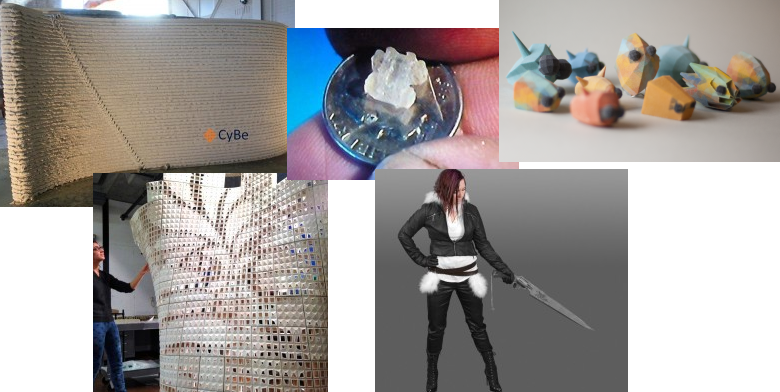This week’s stories we didn’t cover involve lots of talk about size. From the largesse of CyBe’s printed concrete walls and potential houses and Oakland-based Emerging Objects’ planned unveiling of the large structure, Bloom, to the ability to print tiny details through injection, size is definitely an issue this week. What’s also an issue is the individuals who continue to design impressive printable objects such as prosthetic robotic parts, a weapon from the Final Fantasy series, unique generative creatures representing one’s Twitter use, and even a French literature-inspired model of a late 19th century train. There’s also a new company that has a software program allowing you to ditch your computer mouse and use your hand to directly design 3D printable objects.
Easton LaChapelle on “All-American Makers”
One major way people will learn about 3D printing is through shows like “All-American  Makers”, which reveals the devices and personalities behind the scenes. This week, one of 3D printing’s favorite young makers, Easton LaChapelle, made an appearance on the show. While the maker scene is filled with plenty of talented people, LaChapelle has made a name for himself through designing and printing robotic prosthetic hands and arms.
Makers”, which reveals the devices and personalities behind the scenes. This week, one of 3D printing’s favorite young makers, Easton LaChapelle, made an appearance on the show. While the maker scene is filled with plenty of talented people, LaChapelle has made a name for himself through designing and printing robotic prosthetic hands and arms.
Through his company, Unlimited Tomorrow, he hopes to complete an entire exoskeleton, and he’s also launched a GoFundMe campaign to get the job done. He now seeks support from none other than the “All-American Makers” judges. What may get the judges’ attention is that he is still in high school, and has received accolades for his prosthetic projects from no less than President Obama!
Yale Team Prints Literary Train
Other original 3D printing project’s from this week’s news: Yale students have decided to recreate the train that is detailed in Emile Zola’s classic French novel La Bête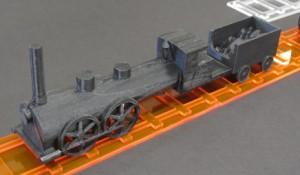 Humaine. The project involved a team of one professor, Morgane Cadieu, and three students in collaboration with Yale’s Center for Engineering Innovation and Design, which is a fully equipped maker lab situated on the Yale campus.
Humaine. The project involved a team of one professor, Morgane Cadieu, and three students in collaboration with Yale’s Center for Engineering Innovation and Design, which is a fully equipped maker lab situated on the Yale campus.
The team translated and interpreted Zola’s detailed descriptions, then passed these descriptions onto the engineering team that used computer software to design and 3D print the final project. The outcome? By sticking as close to the original description as possible, even when Zola’s descriptions seemed exaggerated or metaphorical, they followed the details to amazing final results.
3D Printed Gunblade Weapon
From trains to weapons: Adafruit has added another cool creation to its growing list 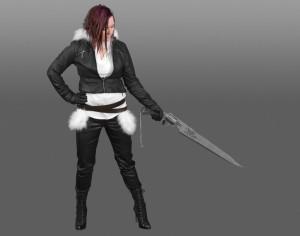 with Squall Leonhart’s iconic gunblade from the Final Fantasy 8 series (1999). Using PLA filament, a 3D printer, Hakko flat pliers, a flush diagonal cutter, scissors, a spatula or knife, one chain/clasp, and medium split rings, and skinny sticks, Adafruit takes you through the necessary steps for you to have your very own gunblade too.
with Squall Leonhart’s iconic gunblade from the Final Fantasy 8 series (1999). Using PLA filament, a 3D printer, Hakko flat pliers, a flush diagonal cutter, scissors, a spatula or knife, one chain/clasp, and medium split rings, and skinny sticks, Adafruit takes you through the necessary steps for you to have your very own gunblade too.
Its previous creations have included a 3D printed apocalyptic gas mask, and these creations are notorious for being difficult to pull off. However, this gunblade is rumored to be one of its easier offerings since it lacks wiring, batteries, and LEDs. So if you have been itching to try one of Adafruit’s creations — this may be the one for you.
Injection Molding Machine from 3D Printer
If Final Fantasy‘s not your thing, you can always try to make an injection molder from your 3D printer instead. 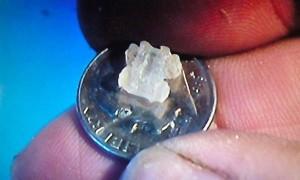 Bruce Kinsley (“bfk”) has been nice enough to share an Instructables tutorial on how to print really small detailed parts from a 3D printer using your printer as an injection molder. His tutorial explains that you will not be able to directly print parts from STL files, but using PLA plastic filament, you can print directly from your printer as many times as you’d like. That is, once you’ve followed all of his steps.
Bruce Kinsley (“bfk”) has been nice enough to share an Instructables tutorial on how to print really small detailed parts from a 3D printer using your printer as an injection molder. His tutorial explains that you will not be able to directly print parts from STL files, but using PLA plastic filament, you can print directly from your printer as many times as you’d like. That is, once you’ve followed all of his steps.
You’ll need the following items: a 3D printer; RTV rubber; knives; a dowel; modeling clay; something to mold with and something to make a mold of; and silicone lubricant. bfk also includes “patience” on your list of necessary supplies, as this is, like Adufruit’s gunblade, a rather time consuming process. You will have to basically make a “sprue” or a pathway between your printer’s extruder and the mold you’ll be using. (You will also need to make, mix, and pour the mold for this part, which is a process included in the tutorial.) Once you have made that part, the rest seems easy by comparison and you can replicate the same small part endlessly if desired.
CyBe’s Concrete Printer is Efficient and Ecological
From printing really small objects to really large objects, the 3D printing technology is taking great strides. Dutch company CyBe has a Pro To R 3DP printer that prints concrete — and you can just imagine the different ways a machine like this can be used. Both efficient and environmentally friendly, this printer’s filament is a special mortar that can create bearable structures within minutes, thus speeding up the printing time considerably. It also uses almost one-third less CO2 compared to standard concrete. It’s not just speed that the company is interested in: strength is also important. This printer can print walls in half an hour that use less concrete than regular walls and are just as strong. (The printer has also been used to make furniture, such as the concrete chair the company features here.)
concrete — and you can just imagine the different ways a machine like this can be used. Both efficient and environmentally friendly, this printer’s filament is a special mortar that can create bearable structures within minutes, thus speeding up the printing time considerably. It also uses almost one-third less CO2 compared to standard concrete. It’s not just speed that the company is interested in: strength is also important. This printer can print walls in half an hour that use less concrete than regular walls and are just as strong. (The printer has also been used to make furniture, such as the concrete chair the company features here.)
There are still some hardware and software kinks to work out, but the printer’s robotic arm, printing span of 3.15 meters, print head of 30 x 30 mm, and speed of 175 mm/second are all important elements that make these concrete printers central to concrete printing’s future creating walls, furniture, and even whole houses!
Oakland’s “Emerging Objects” Plans to Unveil Huge 3D Printed Object
While we are on the subject of 3D printing very large objects, you should consider this 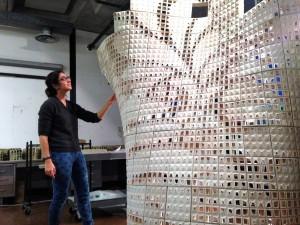 week’s story about an Oakland, California-based company — Emerging Objects — which plans to unveil its project titled “Bloom” at Berkeley’s College of Environmental Design on March 6th. While the public still does not know all of the details, the object will be a 12′ x 12′ x 9′ free standing pavilion made from oxide-free cement polymer that is intended to demonstrate 3D printing’s architectural (and environmental) potential.
week’s story about an Oakland, California-based company — Emerging Objects — which plans to unveil its project titled “Bloom” at Berkeley’s College of Environmental Design on March 6th. While the public still does not know all of the details, the object will be a 12′ x 12′ x 9′ free standing pavilion made from oxide-free cement polymer that is intended to demonstrate 3D printing’s architectural (and environmental) potential.
Emerging Objects claims that this is the largest 3D printed structure to date, if aesthetics, cost, efficiency, and practical applications are figured into the projects too. Emerging Objects has a reputation for printing large and aesthetically pleasing structures, so there is anticipation about this next large object that will be on display at the Berkeley Circus before it is shipped off to Thailand.
Craft Your Printed Clay Objects without Computer Mouse
There’s been lots of news this week about printed objects’ size: whether it be large architectural girth or small detailed objects. This next story involves technique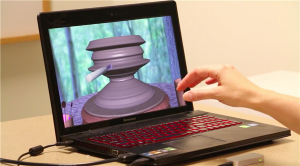 more than size, as Zero UI plans to release a program called “Handy Potter” that uses a depth-sensing camera and intelligent algorithms so 3D printable designs can be made by hand instead of a computer mouse.
more than size, as Zero UI plans to release a program called “Handy Potter” that uses a depth-sensing camera and intelligent algorithms so 3D printable designs can be made by hand instead of a computer mouse.
No need to learn complicated CAD file technology with this innovative program that is the brainchild of Purdue University’s Professor of Mechanical Engineering, Karthik Romani (who is also the Founder of Zero UI). Now makers can focus on the design elements and leave the more complicated tasks to the algorithm experts.
3D Printed Figures Represent French Twitter Users
In order to turn quantifiable virtual data into three-dimensional forms, UK designer 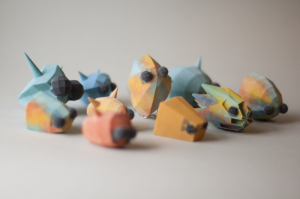 Brendan Dawes had the idea for “Doris Le Bot: Unique Generative Creatures Made from Tweets.” This is a project that created unique representative figures for French Twitter users if they tweeted “@dorislebot” on January 27, 2015. Based on the information in the Twitter profiles, such as their years of use, how many followers they had vs. people they followed, and how many favorites a user’s profile had, a Superformula algorithm would generate a unique creature for each Twitter user. For example, if you had more than 5,000 followers your creature would have a jagged tail and “power users” received multi-colored stripes.
Brendan Dawes had the idea for “Doris Le Bot: Unique Generative Creatures Made from Tweets.” This is a project that created unique representative figures for French Twitter users if they tweeted “@dorislebot” on January 27, 2015. Based on the information in the Twitter profiles, such as their years of use, how many followers they had vs. people they followed, and how many favorites a user’s profile had, a Superformula algorithm would generate a unique creature for each Twitter user. For example, if you had more than 5,000 followers your creature would have a jagged tail and “power users” received multi-colored stripes.
After the digital creatures were created, some were 3D printed at the event location to further create a real-time manifestation of a virtual data-generating event. Dawes wanted a way to show that data tracking sensors can be used to represent the data in different ways — including representing your Twitter profile with unique emblematic 3D printed creatures.
And those are the stories we didn’t cover this week! Let us know what you think about this crop of stories over at the 3D Printing Stories We Missed forum thread at 3DPB.com.
Subscribe to Our Email Newsletter
Stay up-to-date on all the latest news from the 3D printing industry and receive information and offers from third party vendors.
You May Also Like
3D Printing Unpeeled: New Arkema Material for HP, Saddle and Macro MEMS
A new Arkema material for MJF is said to reduce costs per part by up to 25% and have an 85% reusability ratio. HP 3D HR PA 12 S has been...
3D Printing News Briefs, January 20, 2024: FDM, LPBF, Underwater 3D Printer, Racing, & More
We’re starting off with a process certification in today’s 3D Printing News Briefs, and then moving on to research about solute trapping, laser powder bed fusion, and then moving on...
3D Printing Webinar and Event Roundup: December 3, 2023
We’ve got plenty of events and webinars coming up for you this week! Quickparts is having a Manufacturing Roadshow, America Makes is holding a Member Town Hall, Stratafest makes two...
Formnext 2023 Day Three: Slam Dunk
I’m high—high on trade show. I’ve met numerous new faces and reconnected with old friends, creating an absolutely wonderful atmosphere. The excitement is palpable over several emerging developments. The high...


